The Importance of Chemical Processes in Waste Water Treatment
The Importance of Chemical Processes in Waste Water Treatment
Blog Article
Strategic Approaches to Improve Waste Water Therapy Effectiveness and Decrease Environmental Impact
In the world of waste water treatment, the pursuit for improved efficiency and reduced ecological impact is a continuous difficulty that demands critical options. The integration of innovative therapy technologies, energy-efficient procedures, resource recovery methods, enhanced nutrient elimination methods, and clever tracking and control systems stands for a diverse framework for resolving these pressing problems.
Advanced Therapy Technologies
Innovative membrane layer purification systems have actually transformed sophisticated wastewater therapy procedures, dramatically enhancing the elimination of impurities. This modern technology has shown to be extremely reliable in getting rid of a wide range of pollutants, consisting of drugs, hefty steels, and organic substances, which are usually testing to eliminate via traditional treatment approaches.
Moreover, membrane layer purification systems offer numerous advantages over standard therapy techniques. They need less area, create higher-quality effluent, and are much more resistant to fluctuations in influent water quality. In addition, these systems are highly functional and can be easily integrated into existing therapy plants or utilized as standalone units for decentralized applications. As the demand for tidy water remains to rise, the fostering of sophisticated membrane purification modern technologies is necessary to make certain effective and lasting wastewater therapy methods.
Energy-Efficient Processes
The integration of energy-efficient procedures in wastewater treatment systems is crucial for enhancing resource use and reducing operational costs. One crucial strategy to boosting power efficiency in wastewater treatment is the usage of sophisticated oygenation systems, such as great bubble diffusers or surface area aerators, which can boost oxygen transfer performance and reduce power consumption.
Furthermore, optimizing process control and automation through the use of sophisticated sensors and checking systems can boost total power performance by readjusting procedures in real-time based upon real demand and conditions. Executing energy audits and on a regular basis checking power efficiency signs are necessary techniques to recognize locations for enhancement and track energy-saving efforts efficiently. In general, the fostering of energy-efficient procedures in wastewater treatment not only profits the environment yet additionally adds to long-lasting cost financial savings and operational sustainability.
Source Recuperation Methods
With a concentrate on optimizing source utilization and sustainability in wastewater therapy systems, the application of resource recuperation techniques becomes a pivotal facet in improving operational performance. Resource recovery approaches in wastewater treatment involve the recognition and extraction of beneficial resources from the waste stream, thereby transforming what was when thought about waste right into an important property. By implementing source recovery techniques such as nutrient elimination and recovery, power generation from raw material, and the manufacturing of recyclable water, wastewater treatment plants can lessen environmental impact while optimizing effectiveness.

Boosted Nutrient Elimination Methods
Carrying out sophisticated nutrient removal techniques is important for optimizing the performance of wastewater therapy systems. Improved nutrient removal plays a crucial duty in decreasing the ecological effect of treated effluent released right into water bodies. One of the vital strategies go made use of for improved nutrient removal is the procedure of biological nutrient removal (BNR), which entails the removal of nitrogen and phosphorus through organic procedures. This can be achieved through the usage of specialized bacteria that can convert nitrogen substances right into inert nitrogen gas through denitrification, and gather phosphorus within their cells with a process called boosted biological phosphorus elimination (EBPR)

In enhancement to BNR, progressed therapy approaches such as membrane layer bioreactors (MBRs) and created marshes can additionally be used to boost nutrient elimination effectiveness. By including these sophisticated nutrient elimination strategies right into wastewater therapy districts, systems and markets can effectively reduce nutrient contamination and safeguard the atmosphere.
Smart Surveillance and Control Equipment
Utilizing sophisticated technology, the assimilation of clever surveillance and control systems reinvents the operational performance of wastewater therapy facilities. These systems incorporate innovative sensing units and information analytics to continually keep an eye on crucial specifications such as pH levels, turbidity, dissolved oxygen, and circulation prices in real-time. By gathering and evaluating this data, drivers can obtain valuable understandings right into the performance of the treatment processes, allowing proactive modifications to optimize therapy efficiency.
Smart surveillance and control systems also sustain remote monitoring abilities, allowing drivers to accessibility real-time data and control features from off-site locations. This remote access enhances functional flexibility and responsiveness, allowing speedy interventions in situation of system breakdowns or fluctuations in influent top quality. Additionally, the anticipating upkeep abilities of these systems aid prevent devices failings and decrease downtime, ultimately enhancing the total reliability of wastewater therapy operations (Waste Water Treatment).
Verdict
Finally, tactical techniques such as innovative treatment innovations, energy-efficient procedures, source recovery techniques, improved nutrient elimination techniques, and wise tracking and control systems play an important duty in boosting wastewater treatment efficiency and reducing environmental influence. By applying these strategies, wastewater treatment plants can improve their total efficiency, decrease power intake, recoup beneficial sources, and make certain conformity with ecological guidelines. These techniques are crucial for lasting and reliable wastewater administration practices.

In conclusion, strategic strategies such as sophisticated treatment technologies, energy-efficient procedures, resource healing strategies, boosted nutrient elimination methods, and wise monitoring and control systems play an essential duty in improving wastewater treatment efficiency and decreasing environmental influence.
Report this page